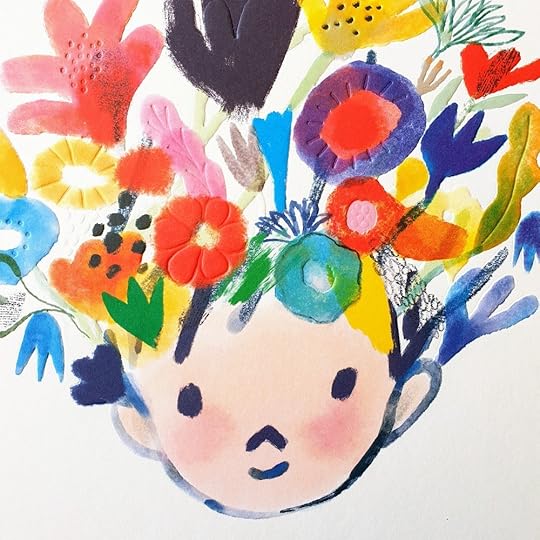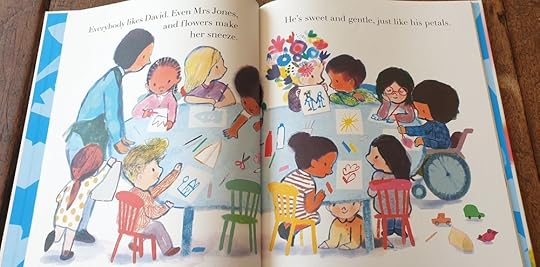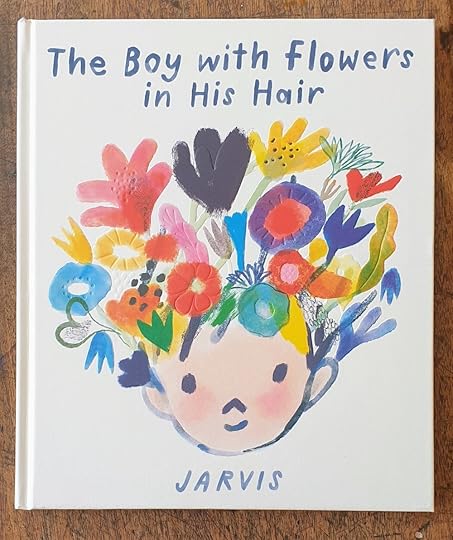The Boy with Flowers in his Hair: redefining masculinity and modelling empathy
 The Boy with Flowers in His Hair by Jarvis(Walker Books, 2022)Good to Read for:its diverse and inclusive cast of charactersdiscussions about mental/physical illnessredefining masculinityThe Boy with Flowers in His Hair is a splendid example of a diverse and inclusive picture book. Different ethnicities abound (a child wearing glasses and a wheelchair user are also included). But it’s the visually striking David (a.k.a. the boy with flowers in his hair) who stands out as being different.
The Boy with Flowers in His Hair by Jarvis(Walker Books, 2022)Good to Read for:its diverse and inclusive cast of charactersdiscussions about mental/physical illnessredefining masculinityThe Boy with Flowers in His Hair is a splendid example of a diverse and inclusive picture book. Different ethnicities abound (a child wearing glasses and a wheelchair user are also included). But it’s the visually striking David (a.k.a. the boy with flowers in his hair) who stands out as being different. 
There’s no explanation as to why David has flowers in his hair. (At first, I assumed he put them there. But as the story unfolds, it’s revealed that the colourful blooms are actually growing.) It’s surreal, even for a picture book. But David’s unusual trait is not what the story’s about – because from the start, David is accepted by his class. His flowers aren’t an issue. Everybody likes him (‘even Mrs Jones, and flowers make her sneeze’)!
The story is narrated by another boy, David’s best friend. They do what all besties do – jump in puddles, make up songs and run away from bees (attracted to the flowers in David’s hair!). It’s an idyllic reflection on the carefree, fun-filled days of childhood.
But then something happens.
I was watering David’s hair and one of his petals came off in my hand.
That afternoon, he didn’t want to play.
Jarvis intentionally leaves the event vague. But the unspecified trauma changes David. He becomes quiet and withdrawn and loses his smile. (In an interview with the Centre for Literacy in Primary Education (CLPE), Jarvis says the loss of David’s colourful flowers represented a kind of depression or illness: “Something that can’t be explained or easily fixed.”)
David’s sudden emotional reaction and vulnerability apply to many tragic situations that can affect kids’ lives. So leaving the event open to interpretation was a smart move by Jarvis.
Significantly, David’s flowery hair – once emblematic of the happy-go-lucky, popular child – now becomes ‘twiggy, spiky and brittle’ – a visual metaphor for how David’s emotional health has changed. His classmates are unnerved and warily keep their distance – except for our narrator. He is loyal and brave and faithfully stays by his best friend’s side:
I got a few scratches, but it wasn’t David’s fault.
Artistic and proactive, the boy finds a creative solution to support his ailing friend:
I asked Mrs Jones for a paintbrush,
and some scissors,
and I found a way…
to give David his colour back.

The other children are inspired. Everybody joins in, helping make enough paper flowers to cover David’s head once more until he ‘[seems] back to how he was before.’
Almost.
(Interestingly, Jarvis says this is one of his favourite parts of his story. “Because sometimes the biggest things can’t always be ‘solved’.”)
Gradually, David’s own flowers begin to bloom once more. (‘And soon enough, all those buzzy bees were back!’). But his best friend keeps a big boxful of paper flowers, ‘just in case [David] ever needs them.’
Because he’s my best friend,
And I am his.
 If you need it, here’s one final reason to share The Boy with Flowers in his Hair: it opens up a discussion about what it means to be masculine.
If you need it, here’s one final reason to share The Boy with Flowers in his Hair: it opens up a discussion about what it means to be masculine. Which is a good thing: Doing so helps pave the way to a healthier future for men and women. Let me explain how – and why that’s important:
Flowers are traditionally associated with women and girls. So associating a boy with flowers breaks down a gendered trope in itself. (What’s more, David is happy to be his own flowery self – and accepted.)
David is described by the narrator as ‘sweet and gentle, just like his petals.’
His best friend (another boy) also demonstrates gentle, loving care.
The two best friends are demonstrative of their affection for each other.
The story sends the message (pertinent to boys) that it’s OK to be creative.
I was a sensitive, gentle, creative boy. Did I fit in the traditional boy mould? Absolutely not! You might find me near a sports pitch – but only if I was watching gulls! At times it was a struggle. The Boy with Flowers in his Hair will affirm a similar child. By presenting an alternative way to be a boy/masculine, the story effectively challenges damaging gender tropes. It gives children – both boys and girls – permission to freely explore their interests: be that acting out domestic chores, caring for the baby doll, kicking a football or putting on a spacesuit.
I’ve used this quote before (in my review of How To Be a Lion), but it bears repeating:
Too often strength and sensitivity are presented as mutually exclusive… We need to teach compassion, respect and empathy at an early, foundational age. If we can teach this to boys at around five, and demonstrate that being gentle, sensitive or emotionally engaged isn’t a weakness, but part of being a fully rounded grown-up man, then we’re getting the message through to them before toxic [masculine] attitudes have a chance to solidify.
- Authors steer boys from toxic masculinity with gentler heroes (The Guardian)
STORIES WORTH SHARINGThe Boy with Flowers in His Hair by Jarvis(Walker Books, 2022)Good to Read for:its diverse and inclusive cast of charactersdiscussions about mental/physical illnessredefining masculinityCopyright © 2022 JarvisFrom THE BOY WITH FLOWERS IN HIS HAIR by JarvisReproduced by permission of Walker Books Ltd, London, SE11 5HJ www.walker.co.ukGOOD TO READPicture books that challenge traditional ideas of masculinitySo Much by Trish Cooke & Helen Oxenbury
NO! by Tracey Corderoy & Tim Warnes
The Boy with Flowers in His Hair by Jarvis
Julian is a Mermaid by Jessica Love
How To Be a Lion by Ed Vere
BUY THE BOOKPowered by Bookshop.org
Supporting independent bookshops
 “Explores the power of friendship and acceptance.” – Reading Zone
“Explores the power of friendship and acceptance.” – Reading Zone“A touching demonstration of kindness and supportiveness.”– Red Reading Hub buy UK BUY US * I EARN COMMISSION FROM THESE LINKS #AD/AFFRELATED ARTICLESOURCESThe Boy with Flowers in His Hair by Jarvis (Walker Books, 2022) Q&A with Jarvis all about The Boy with Flowers in His Hair (CLPE.org, 21 March 2022) Authors steer boys from toxic masculinity with gentler heroes (Donna Furguson, The Guardian, 14 July 2018)© 2022 BY TIM WARNES(UNLESS OTHERWISE ATTRIBUTED)****USE OF THIRD PARTY COPYRIGHTED MATERIAL FALLS UNDER FAIR USE/FAIR DEALING PRACTICE.
My Life in Books
For lovers of kid lit, this memoir - My Life in Books - is intended to give you the confidence and encouragement to share your own passion; to help you make lasting connections through kids’ books.
Originally posted at www.timwarnes.com ...more
- Tim Warnes's profile
- 30 followers



